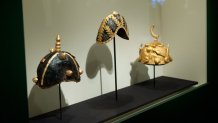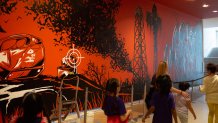Nothing less than a royal delegation would be appropriate to introduce The Power of Gold: Asante Royal Regalia from Ghana, now on display at the Dallas Museum of Art through August 12.
The Asante king, His Majesty Otumfuo Osei Tutu II, Asantehene sent his second-in-command to Dallas with a special message. “He is deeply appreciative of this special exhibition that has been mounted because gold is a symbol of the great Asantes and we are a proud nation within modern Ghana,” Daasebre Osei Bonsu II, Mamponghene said, fully dressed in Asante regalia.
This exhibition of over 250 objects is a window into the Asante kingdom, the largest and most prominent group of related Akan peoples in southern Ghana. With objects from the Dallas Museum of Art’s collections, private collections and several other museums including the British Museum and the Metropolitan Museum of Art, the exhibition traces the important role of gold in this powerful West African polity.
“What is the power of gold? The power to acquire luxury items from wherever in the world, the power to impress. We are dazzled and bedazzled by the gold we see on him and it could be used to get some allies who strayed over this way to come back to the center,” Dr. Roslyn A. Walker, the museum’s Senior Curator of the Arts of Africa, the Americas, and the Pacific, and The Margaret McDermott Curator of African Art, said.
The exhibition reflects the Asante kingdom’s participation in the gold trade with displays of gold weights, gold dust and evidence of cultural exchange with 14th century Egyptian brass vessels decorated with Arabic calligraphy. Part of the exhibition reflects the important role of women as the Asante society is matrilineal. Displayed near a woman’s kente cloth, a sculpted figure depicts a mother lovingly nursing a daughter. “Daughters are valued in society,” Walker said. The exhibition also includes photographs of Asante living in the North Texas area, wearing Asante regalia.

Much of the exhibition is devoted to the Asante kingdom’s state regalia. Ceremonial stools crafted for specific individuals reflect status and stage of life. “Most of the stools came out in the 19th century. You’ll notice they are various sizes. Some are for women, some are for rulers. They all have the same basic shape of a curved seat, a flat platform bottom and five supports,” Walker said. “The grander the stool, the more important the ruler.”
Local
The latest news from around North Texas.
A large state umbrella fills a significant portion of the exhibition. “The umbrella is very important. It marks the spot where the Asantehene [king] is seated or not seated. These umbrellas were very, very fancy, made of the most beautiful textiles,” Walker said.
Among cast gold sword ornaments, elbow and wrist ornaments, and elaborate headwear are the staffs of the king’s linguists. “The linguist is the king’s spokesman, his ambassador, his lawyer, his fount of knowledge about tradition, his public relations person,” Walker said. “He is very wise, and it is his job when the king is talking to anyone to make sure he is saying the most appropriate words for the occasion, that he is responding in an intelligent way that is based on Asante tradition and Asante law.” The linguist’s staff reflects Asante proverbs and has become larger over time, reflecting his importance to the king.
With the royal delegation modeling similar pieces as those on display in the exhibition, it is obvious that gold is part of an important living tradition. “Goldsmithing is alive and well in modern-day Asante culture,” Walker said.

A modern, temporary work of art in the museum’s concourse reflects an alternative vision of a familiar culture: the Texas landscape. Fine Lands, a striking red and black graphic mural on view through September 3, is the first solo American museum project of Mexican artist, Minerva Cuevas. Known for her politically-responsive work in a variety of media, Cuevas has filled the walls and ceilings of the museum’s corridor with a modern vision of Texas’ indigenous wildlife. “I think, in general, all this landscape representing nature and industry, even though it is part of our lives and even the foundations of our lives, it is invisible,” Cuevas said.
Inspired by corporate advertising campaigns, Cuevas uses graphic imagery and a comic book style to fuse industrial motifs and natural elements. “I’ve used comic book style in the past and I think it makes the graphic style very accessible to all kinds of people. That was important in this case because I always take into account the kind of public an institution has. I knew that we would have all kinds of visitors interested not only in contemporary art, but also a wide range of arts from different times and styles,” Cuevas said.
The landscape of the mural reflects the human effect on nature with turtles wearing backpacks representing immigrants and an oil geyser transforming into bats. Some creatures reflect cultural shifts in industry while others offer a mischievous vision on humanity’s disregard for the landscape. “Ants are very often associated with labor, hard labor. So one is connected with agriculture and the next one is connected with industry,” Cuevas said. “One of the playful things is the prairie dogs with bullet-proof vests because I learned that sometimes hunters hunt prairie dogs as just a fun activity, which I find shameful.”
Red light baths the mural, enticing visitors to immerse themselves in this landscape and share it with friends on social media. “I like it because it generates an atmosphere if you get closer for your selfie,” Cuevas said.
MORE: DMA.org



